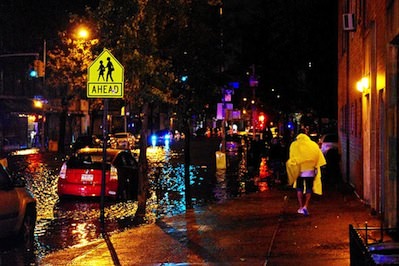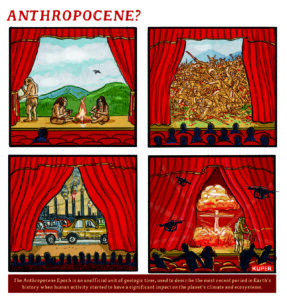Frankenstorm
In time for its second anniversary, Hurricane Sandy, one of the worst natural disasters in American history, has a pair of new biographies. Hurricane Sandy floods Manhattan's East Village. Photo by david_shankbone (CC BY 2.0)
Hurricane Sandy floods Manhattan's East Village. Photo by david_shankbone (CC BY 2.0)
|
To see long excerpts from “Storm Surge” at Google Books, click here. |
|
To see long excerpts from “Superstorm” at Google Books, click here. |
“Storm Surge: Hurricane Sandy, Our Changing Climate, and Extreme Weather of the Past and Future” A book by Adam Sobel
“Superstorm: Nine Days Inside Hurricane Sandy” A book by Kathryn Miles
National Weather Service forecaster James Cisco captured the growing dread Americans felt in late October 2012 as Hurricane Sandy bore down on the East Coast. Writing in an obscure Weather Service bulletin, he warned that the storm was expected to morph into a “hybrid vortex” — not quite a hurricane, but not quite a typical winter storm, “inviting perhaps a ghoulish nickname for the cyclone along the lines of ‘Frankenstorm,’ an allusion to Mary Shelley’s gothic creature of synthesized elements.” Cisco’s coinage — Frankenstorm — caught on. It tempted those of us closely following Sandy to think of it less as a meteorological event and more as a monster, hell-bent on wreaking havoc — possibly in retribution for our careless experiments with earth’s climate.
In time for its second anniversary, Hurricane Sandy, one of the worst natural disasters in American history, has a pair of new biographies. The first is by Adam Sobel, a Columbia University atmospheric scientist whose work has taken him around the globe. “Storm Surge” is a masterful account of the science and policy implications of Sandy, a storm he watched rage just outside his New York City apartment window.
For those of us who watched Sandy’s horror unfold in real time, on computer screens and on boardwalks, Sobel excels at answering our most burning question: What was that thing? To provide his answer, he nerds out on the nuts and bolts of tropical meteorology, dissecting impenetrable National Weather Service bulletins and debunking the urge to over-attribute Sandy’s unprecedented behavior to climate change. At times “Storm Surge” can be overly wonky, reducing Sandy to a case study in a meteorology textbook, but mostly Sobel is able to navigate the complex science behind Sandy’s twists and turns with accessibility, precision and authority.
Sobel shines most when he speaks from personal experience. As a lifelong New Yorker who just happens to be one of the world’s experts on the changing nature of hurricanes in a warming world, he describes his own midnight walk from his Morningside Heights apartment down to the swollen Hudson River on the night of Sandy’s landfall in a way that brings chills. Sandy’s approach toward his home city marked the moment when Sobel’s fascination evolved from intellectual curiosity to something more: He “began to feel fear as well.”
Sobel deeply cares about his city and his planet and writes as a scientist and activist without blurring the line between the two. He recounts Mayor Michael Bloomberg’s fumbled pre-landfall press conference where he said Sandy wouldn’t produce “a tropical storm or hurricane-type surge” and marvels at how, post-landfall, Bloomberg became a “single issue voter,” bucking his independent political affiliation to emphasize the importance of action on climate change in his endorsement of Obama for president.
On the cover of Sobel’s book is the now iconic image of the Seaside Heights, N.J., roller coaster, half-submerged in the ocean in the storm’s aftermath — a metaphor for humanity’s seeming disregard for the growing threat of climate change. Though Sobel’s words may not be quite enough to force those still on the fence into a Bloombergian climate epiphany, it’s clear he sees Sandy as evidence of our collective vulnerability should we continue on our current path as a civilization.If Sobel’s skill is diving into Sandy’s mind — analyzing why the storm did what it did — Kathryn Miles glimpses its soul. Her “Superstorm” reads like the script of a blockbuster movie, transforming that Halloween storm into a nightmarish monster come to life. She provides horrifying vignettes of the storm’s many personal tragedies.
The book expands on a story Miles wrote for Outside magazine in February 2013, a harrowing, behind-the scenes chronicle of the HMS Bounty, a tall ship that somehow found its way into the heart of the storm with tragic consequences. But “Superstorm” is much more than just a longer version of the magazine piece. Miles builds on that story to give us a broad picture of all that Sandy meant for so many caught in its path.
Miles whirls us alternately from the hangar of the Hurricane Hunters, whose macho pilots can’t wait for their next flight, to the windswept deck of Disney’s Fantasy cruise liner, where seasick tourists are buffeted by Sandy’s high seas, to the National Weather Service forecast bunker in Miami, where the shades are drawn to prevent glare on computer screens. But “Superstorm” is still, ultimately, a story of the Bounty’s dramatic demise. Using the ship as a metaphor, Miles captures the power of the sea and our increasingly futile attempts to tame its rise.
The author is an avid sailor, and it shows. She’s awed by the ocean’s fury and those who devote their life to it. Much of the book focuses on Sandy’s influence at sea, including, most memorably, a detailed description of what it’s like to be thrown off a sinking ship in the middle of the biggest Atlantic hurricane we’ve ever known. The result is what you might expect from Stephen King if he wrote nonfiction: a gripping plot with flashes of pure terror. Most astonishing, everything Miles describes actually happened.
Miles knows the sea just as Sobel knows the sky, making their books complementary. Though Miles tries to anchor her brilliant character drama with meteorological science, she seems a bit overmatched at times, at one point confusing square feet with square miles and trudging through the technical requirements the Weather Service uses for a tropical depression. Readers would benefit from reading Sobel first (as an explainer), then Miles (for thrills).
What Miles lacks in scientific polish, she more than makes up for in the minute-by-minute tension among the characters she follows as Sandy weaves through their lives in unexpected ways. A good example of this is her description of the National Hurricane Center’s decision — days in advance — not to issue official hurricane warnings for the vast swath of Northeast coastline that Sandy’s wind and waves were approaching. She describes the tangled National Weather Service bureaucracy and its alphabet soup of storm-surge acronyms, but still manages to highlight the individuals — a blogger, a Coast Guard rescue swimmer and others — who rose to hero status in an effort to save lives.
As Sandy swelled into the kind of storm that defied convention, confusion set in. In “Superstorm,” Miles places equal blame for that on the National Hurricane Center and Mayor Bloomberg. A pair of National Weather Service employees emerge as rogues, flouting convention and bureaucracy to emphasize a message that seems obvious in hindsight: That was not any ordinary storm.
Eric Holthaus is a meteorologist and frequent contributor to Slate magazine’s Future Tense blog.
©2014, Washington Post Book World Service/Washington Post Writers Group
Your support matters…Independent journalism is under threat and overshadowed by heavily funded mainstream media.
You can help level the playing field. Become a member.
Your tax-deductible contribution keeps us digging beneath the headlines to give you thought-provoking, investigative reporting and analysis that unearths what's really happening- without compromise.
Give today to support our courageous, independent journalists.






You need to be a supporter to comment.
There are currently no responses to this article.
Be the first to respond.